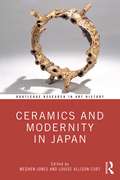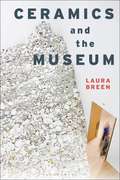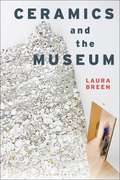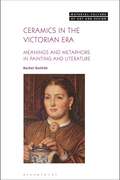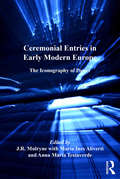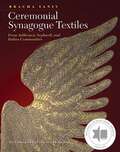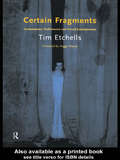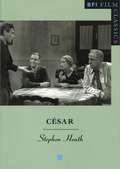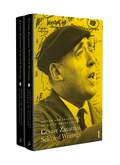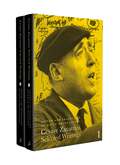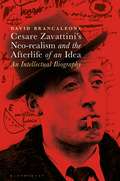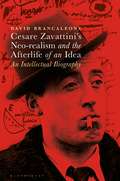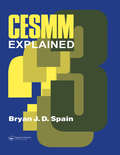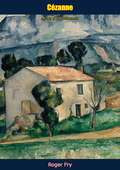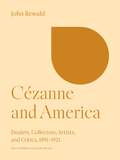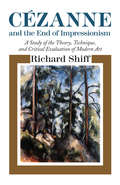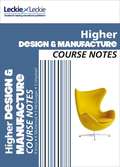- Table View
- List View
Ceramics and Modernity in Japan (Routledge Research in Art History)
by Meghen M. Jones Louise Allison CortCeramics and Modernity in Japan offers a set of critical perspectives on the creation, patronage, circulation, and preservation of ceramics during Japan’s most dramatic period of modernization, the 1860s to 1960s. As in other parts of the world, ceramics in modern Japan developed along the three ontological trajectories of art, craft, and design. Yet, it is widely believed that no other modern nation was engaged with ceramics as much as Japan—a "potter’s paradise"—in terms of creation, exhibition, and discourse. This book explores how Japanese ceramics came to achieve such a status and why they were such significant forms of cultural production. Its medium-specific focus encourages examination of issues regarding materials and practices unique to ceramics, including their distinct role throughout Japanese cultural history. Going beyond descriptive historical treatments of ceramics as the products of individuals or particular styles, the closely intertwined chapters also probe the relationship between ceramics and modernity, including the ways in which ceramics in Japan were related to their counterparts in Asia and Europe. Featuring contributions by leading international specialists, this book will be useful to students and scholars of art history, design, and Japanese studies.
Ceramics and Modernity in Japan (Routledge Research in Art History)
by Meghen M. Jones Louise Allison CortCeramics and Modernity in Japan offers a set of critical perspectives on the creation, patronage, circulation, and preservation of ceramics during Japan’s most dramatic period of modernization, the 1860s to 1960s. As in other parts of the world, ceramics in modern Japan developed along the three ontological trajectories of art, craft, and design. Yet, it is widely believed that no other modern nation was engaged with ceramics as much as Japan—a "potter’s paradise"—in terms of creation, exhibition, and discourse. This book explores how Japanese ceramics came to achieve such a status and why they were such significant forms of cultural production. Its medium-specific focus encourages examination of issues regarding materials and practices unique to ceramics, including their distinct role throughout Japanese cultural history. Going beyond descriptive historical treatments of ceramics as the products of individuals or particular styles, the closely intertwined chapters also probe the relationship between ceramics and modernity, including the ways in which ceramics in Japan were related to their counterparts in Asia and Europe. Featuring contributions by leading international specialists, this book will be useful to students and scholars of art history, design, and Japanese studies.
Ceramics and the Museum
by Laura BreenCeramics and the Museum interrogates the relationship between art-oriented ceramic practice and museum practice in Britain since 1970.Laura Breen examines the identity of ceramics as an art form, drawing on examples of work by artist-makers such as Edmund de Waal and Grayson Perry; addresses the impact of policy making on ceramic practice; traces the shift from object to project in ceramic practice and in the evolution of ceramic sculpture; explores how museums facilitated multisensory engagement with ceramic material and process, and analyses the exhibition as a text in itself. Proposing the notion that 'gestures of showing,' such as exhibitions and installation art, can be read as statements, she examines what they tell us about the identity of ceramics at particular moments in time. Highlighting the ways in which these gestures have constructed ceramics as a category of artistic practice, Breen argues that they reveal gaps between narrative and practice, which in turn can be used to deconstruct the art.
Ceramics and the Museum
by Laura BreenCeramics and the Museum interrogates the relationship between art-oriented ceramic practice and museum practice in Britain since 1970.Laura Breen examines the identity of ceramics as an art form, drawing on examples of work by artist-makers such as Edmund de Waal and Grayson Perry; addresses the impact of policy making on ceramic practice; traces the shift from object to project in ceramic practice and in the evolution of ceramic sculpture; explores how museums facilitated multisensory engagement with ceramic material and process, and analyses the exhibition as a text in itself. Proposing the notion that 'gestures of showing,' such as exhibitions and installation art, can be read as statements, she examines what they tell us about the identity of ceramics at particular moments in time. Highlighting the ways in which these gestures have constructed ceramics as a category of artistic practice, Breen argues that they reveal gaps between narrative and practice, which in turn can be used to deconstruct the art.
Ceramics in the Victorian Era: Meanings and Metaphors in Painting and Literature (Material Culture of Art and Design)
by Rachel GotliebThis book broadens the discussion of pottery and china in the Victorian era by situating them in the national, imperial, design reform, and domestic debates between 1840 and 1890. Largely ignored in recent scholarship, Ceramics in the Victorian Era: Meanings and Metaphors in Painting and Literature argues that the signification of a pot, a jug, or a tableware pattern can be more fully discerned in written and painted representations.Across five case studies, the book explores a rhetoric and set of conventions that developed within the representation of ceramics, emerging in the late-18th century, and continuing in the Victorian period. Each case study begins with a textual passage exemplifying the outlined theme and closes with an object analysis to demonstrate how the fusing of text, image, and object are critical to attaining the period eye in order to better understand the metaphorical meanings of ceramics.Essential reading not only for ceramics scholars, but also those of material culture, the book mines the rich and diverse archive of Victorian painting and literature, from the avant-garde to the sentimental, from the well-known to the more obscure, to shed light on the at once complex and simple implications of ceramics' agencies at this time.
Ceremonial Entries in Early Modern Europe: The Iconography of Power (European Festival Studies: 1450-1700)
by J. R. Mulryne Maria Ines Aliverti Anna Maria TestaverdeThe fourteen essays that comprise this volume concentrate on festival iconography, the visual and written languages, including ephemeral and permanent structures, costume, dramatic performance, inscriptions and published festival books that ’voiced’ the social, political and cultural messages incorporated in processional entries in the countries of early modern Europe. The volume also includes a transcript of the newly-discovered Register of Lionardo di Zanobi Bartholini, a Florentine merchant, which sets out in detail the expenses for each worker for the possesso (or Entry) of Pope Leo X to Rome in April 1513.
Ceremonial Entries in Early Modern Europe: The Iconography of Power (European Festival Studies: 1450-1700)
by J. R. Mulryne Mariaines Aliverti Annamaria TestaverdeThe fourteen essays that comprise this volume concentrate on festival iconography, the visual and written languages, including ephemeral and permanent structures, costume, dramatic performance, inscriptions and published festival books that ’voiced’ the social, political and cultural messages incorporated in processional entries in the countries of early modern Europe. The volume also includes a transcript of the newly-discovered Register of Lionardo di Zanobi Bartholini, a Florentine merchant, which sets out in detail the expenses for each worker for the possesso (or Entry) of Pope Leo X to Rome in April 1513.
Ceremonial Synagogue Textiles: From Ashkenazi, Sephardi, and Italian Communities (The Littman Library of Jewish Civilization)
by Bracha YanivNational Jewish Book Awards 2019 Finalist for Visual Arts. Richly illustrated and meticulously documented, this is the first comprehensive survey of synagogue textiles to be available in English. Bracha Yaniv, a leading expert in the field of Jewish ceremonial textiles, records their evolution from ancient times to the present. The volume contains a systematic consideration of the mantle, the wrapper, the Torah scroll binder, and the Torah ark curtain and valance, and considers the cultural factors that inspired the evolution of these different items and their motifs. Fabrics, techniques, and modes of production are described in detail; the inscriptions marking the circumstances of donation are similarly subjected to close analysis. Fully annotated plates demonstrate the richness of the styles and traditions in use in different parts of the Jewish diaspora, drawing attention to regional customs. Throughout, emphasis is placed on presenting and explaining all relevant aspects of the Jewish cultural heritage. The concluding section contains transcriptions, translations, and annotations of some 180 inscriptions recording the circumstances in which items were donated, providing a valuable survey of customs of dedication. Together with the comprehensive bibliography, inventory lists, and other relevant documentation, this volume will be an invaluable reference work for the scholarly community, museum curators, and others interested in the Jewish cultural heritage.
Certain Fragments: Texts and Writings on Performance
by Tim EtchellsWhat is the relationship between performance and play? Between performance and technology? Between performance and death? Certain Fragments is an extraordinary exploration of what lies at the heart of contemporary theatre. Written by the artistic director of Forced Entertainment, acknowledged to be Britains most brilliant experimental theatre company (Guardian), Certain Fragments investigates the processes of devising performance, the role of writing in an interdisciplinary theatre, and the influence of the city on contemporary art practice. Tim Etchells unique and provocative voice shifts from intimate anecdote to critical analysis and back again. And as in his theatre-making so in his book: with Certain Fragments Etchells disrupts traditional notions of creative, academic, and intellectual work. The book is an exciting and radical fusion of story-telling and criticism. It also makes available, for the first time, four seminal Forced Entertainment texts by Etchells.
Certain Fragments: Texts and Writings on Performance
by Tim EtchellsWhat is the relationship between performance and play? Between performance and technology? Between performance and death? Certain Fragments is an extraordinary exploration of what lies at the heart of contemporary theatre. Written by the artistic director of Forced Entertainment, acknowledged to be Britains most brilliant experimental theatre company (Guardian), Certain Fragments investigates the processes of devising performance, the role of writing in an interdisciplinary theatre, and the influence of the city on contemporary art practice. Tim Etchells unique and provocative voice shifts from intimate anecdote to critical analysis and back again. And as in his theatre-making so in his book: with Certain Fragments Etchells disrupts traditional notions of creative, academic, and intellectual work. The book is an exciting and radical fusion of story-telling and criticism. It also makes available, for the first time, four seminal Forced Entertainment texts by Etchells.
A Certain Tendency of the Hollywood Cinema, 1930-1980
by Robert B. RayRobert B. Ray examines the ideology of the most enduringly popular cinema in the world--the Hollywood movie. Aided by 364 frame enlargements, he describes the development of that historically overdetermined form, giving close readings of five typical instances: Casablanca, It's a Wonderful Life, The Man Who Shot Liberty Valance, The Godfather, and Taxi Driver. Like the heroes of these movies, American filmmaking has avoided commitment, in both plot and technique. Instead of choosing left or right, avant-garde or tradition, American cinema tries to have it both ways.Although Hollywood's commercial success has led the world audience to equate the American cinema with film itself, Hollywood filmmaking is a particular strategy designed to respond to specific historical situations. As an art restricted in theoretical scope but rich in individual variations, the American cinema poses the most interesting question of popular culture: Do dissident forms have any chance of remaining free of a mass medium seeking to co-opt them?
César (BFI Film Classics)
by Stephen HeathBringing to a close his 'Marseille' trilogy, César (1936) was one of Marcel Pagnol's most significant projects. This text reviews the questions that Pagnol posed in the film, looking at how he reflected the contemporary and artistic culture of the city, around which the trilogy was based. Above all, Stephen Heath looks at César's relation to the contemporary artistic and cultural-historical reality of Marseille, the defining locality of the trilogy and in many ways its main character.
César (BFI Film Classics)
by Stephen HeathBringing to a close his 'Marseille' trilogy, César (1936) was one of Marcel Pagnol's most significant projects. This text reviews the questions that Pagnol posed in the film, looking at how he reflected the contemporary and artistic culture of the city, around which the trilogy was based. Above all, Stephen Heath looks at César's relation to the contemporary artistic and cultural-historical reality of Marseille, the defining locality of the trilogy and in many ways its main character.
Cesare Zavattini: Selected Writings
by David BrancaleoneCesare Zavattini: Selected Writings offers, for the first time in English, a substantive selection of the Italian screenwriter's writings across two volumes. Through translation and detailed cultural and contextual commentary, translator and editor David Brancaleone traces not only Zavattini's theory of the screen, but also his experimentation in new film practices, including the flash-film (film lampo), the inquiry film (film inchiesta), cinema as encounter (cinema d'incontro), the diary film (film diario), the confessional film (film-confessione), and the grass-roots community film (cinema insieme or cinema di tanti per tanti).
Cesare Zavattini: Selected Writings
Cesare Zavattini: Selected Writings offers, for the first time in English, a substantive selection of the Italian screenwriter's writings across two volumes. Through translation and detailed cultural and contextual commentary, translator and editor David Brancaleone traces not only Zavattini's theory of the screen, but also his experimentation in new film practices, including the flash-film (film lampo), the inquiry film (film inchiesta), cinema as encounter (cinema d'incontro), the diary film (film diario), the confessional film (film-confessione), and the grass-roots community film (cinema insieme or cinema di tanti per tanti).
Cesare Zavattini’s Neo-realism and the Afterlife of an Idea: An Intellectual Biography
by David BrancaleoneHow many Zavattinis are there? During a life spanning most of the twentieth century, the screenwriter who wrote Sciuscià, Bicycle Thieves, Miracle in Milan, and Umberto D. was also a pioneering magazine publisher in 1930s Milan, a public intellectual, a theorist, a tireless campaigner for change within the film industry, a man of letters, a painter and a poet. This intellectual biography is built on the premise that in order to understand Zavattini's idea of cinema and his legacy of ethical and political cinema (including guerrilla cinema), we must also tease out the multi-faceted strands of his interventions and their interplay over time. The book is for general readers, students and film historians, and anyone with an interest in cinema and its fate.
Cesare Zavattini’s Neo-realism and the Afterlife of an Idea: An Intellectual Biography
by David BrancaleoneHow many Zavattinis are there? During a life spanning most of the twentieth century, the screenwriter who wrote Sciuscià, Bicycle Thieves, Miracle in Milan, and Umberto D. was also a pioneering magazine publisher in 1930s Milan, a public intellectual, a theorist, a tireless campaigner for change within the film industry, a man of letters, a painter and a poet. This intellectual biography is built on the premise that in order to understand Zavattini's idea of cinema and his legacy of ethical and political cinema (including guerrilla cinema), we must also tease out the multi-faceted strands of his interventions and their interplay over time. The book is for general readers, students and film historians, and anyone with an interest in cinema and its fate.
CESMM 3 Explained
by Bryan SpainCESSM 3 Explained provides a detailed and highly illustrated guide to the use of the new civil engineering standard methods of measurements.
Cézanne: A Study of His Development
by Roger FryThe late Roger Fry was an art critic of unequalled perception and influence. One of his missions was to work for a better understanding of the Impressionist school and, above all, to claim for Cézanne (1839-1906) the great place that was rightfully his. In CÉZANNE Fry wrote a critical analysis which in many aspects has never been surpassed. He achieved with conspicuous success a two-fold aim: to show the essential development of the painter’s genius and to approach his work as it really is; as Fry himself words it, to detect the profound difference between Cézanne’s message and what we have made of it.”The result is a book, couched in Fry’s most lucid, penetrating manner, which is of great technical value to the painter and student, and which offers to the layman an illuminating demonstration of the essential nature of Cézanne’s art.
Cézanne and America: Dealers, Collectors, Artists, and Critics, 1891-1921 (The A. W. Mellon Lectures in the Fine Arts #28)
by John RewaldThe classic work by internationally acclaimed Cézanne scholar John RewaldIn Cézanne and America, John Rewald presents a full account of how Paul Cézanne’s reputation and influence became established in America between 1891 and 1921, and of how some of the world’s largest collections of his works were formed in the United States. This is the fascinating story of enthusiastic young American artists who took up Cézanne’s cause after they discovered him in Paris. It is also the story of the discerning early American collectors of his work—Leo and Gertrude Stein, the Havemeyers, and John Quinn, among others—many of whom made their first purchases from Cézanne’s wily dealer Ambroise Vollard in Paris, or from the dealer Alfred Stieglitz in New York, and of the beginning of the famous collection of Dr. Albert C. Barnes. Each chapter is illustrated not only with Cézanne’s works but also with portraits of collectors and critics and with previously unpublished pages from diaries, dealers’ ledgers, and Cézanne’s own correspondence.
Cezanne and the End of Impressionism: A Study of the Theory, Technique, and Critical Evaluation of Modern Art
by Richard ShiffDrawing on a broad foundation in the history of nineteenth-century French art, Richard Shiff offers an innovative interpretation of Cézanne's painting. He shows how Cézanne's style met the emerging criteria of a "technique of originality" and how it satisfied critics sympathetic to symbolism as well as to impressionism. Expanding his study of the interaction of Cézanne and his critics, Shiff considers the problem of modern art in general. He locates the core of modernism in a dialectic of making (technique) and finding (originality). Ultimately, Shiff provides not only clarifying accounts of impressionism and symbolism but of a modern classicism as well.
Cezanne and the End of Impressionism: A Study of the Theory, Technique, and Critical Evaluation of Modern Art
by Richard ShiffDrawing on a broad foundation in the history of nineteenth-century French art, Richard Shiff offers an innovative interpretation of Cézanne's painting. He shows how Cézanne's style met the emerging criteria of a "technique of originality" and how it satisfied critics sympathetic to symbolism as well as to impressionism. Expanding his study of the interaction of Cézanne and his critics, Shiff considers the problem of modern art in general. He locates the core of modernism in a dialectic of making (technique) and finding (originality). Ultimately, Shiff provides not only clarifying accounts of impressionism and symbolism but of a modern classicism as well.
Cezanne and the End of Impressionism: A Study of the Theory, Technique, and Critical Evaluation of Modern Art
by Richard ShiffDrawing on a broad foundation in the history of nineteenth-century French art, Richard Shiff offers an innovative interpretation of Cézanne's painting. He shows how Cézanne's style met the emerging criteria of a "technique of originality" and how it satisfied critics sympathetic to symbolism as well as to impressionism. Expanding his study of the interaction of Cézanne and his critics, Shiff considers the problem of modern art in general. He locates the core of modernism in a dialectic of making (technique) and finding (originality). Ultimately, Shiff provides not only clarifying accounts of impressionism and symbolism but of a modern classicism as well.
Cezanne and the End of Impressionism: A Study of the Theory, Technique, and Critical Evaluation of Modern Art
by Richard ShiffDrawing on a broad foundation in the history of nineteenth-century French art, Richard Shiff offers an innovative interpretation of Cézanne's painting. He shows how Cézanne's style met the emerging criteria of a "technique of originality" and how it satisfied critics sympathetic to symbolism as well as to impressionism. Expanding his study of the interaction of Cézanne and his critics, Shiff considers the problem of modern art in general. He locates the core of modernism in a dialectic of making (technique) and finding (originality). Ultimately, Shiff provides not only clarifying accounts of impressionism and symbolism but of a modern classicism as well.
CFE Higher Design and Manufacture (Course Notes For Sqa Exams Ser.)
by Richard Knox Kirsty McDermid Stuart McGougan Scott Urquhart Leckie Leckie Staff Collins UK Publishing StaffExam Board: SQA Level: Higher Subject: Design and Manufacture First Teaching: 2014, First Exam: 2015 The Higher Design & Manufacture Course Notes helps teachers and students map their route through the CfE programme, providing comprehensive and authoritative guidance for the course. • Full coverage of the new Higher course specifications with list of learning intentions • Attractive layout with clear text features • Key questions highlight crucial concepts and techniques that need to be grasped by students in order to progress to the next learning intention • What the examiner/assessor is looking for to help teachers & students feel secure • End of unit material – unit assessment, exam-style questions with worked answers and examiners commentary, self-assessment Course Notes give a practical, supportive approach to help deliver the new curriculum and offer a blend of sound teaching and learning with assessment guidance.
